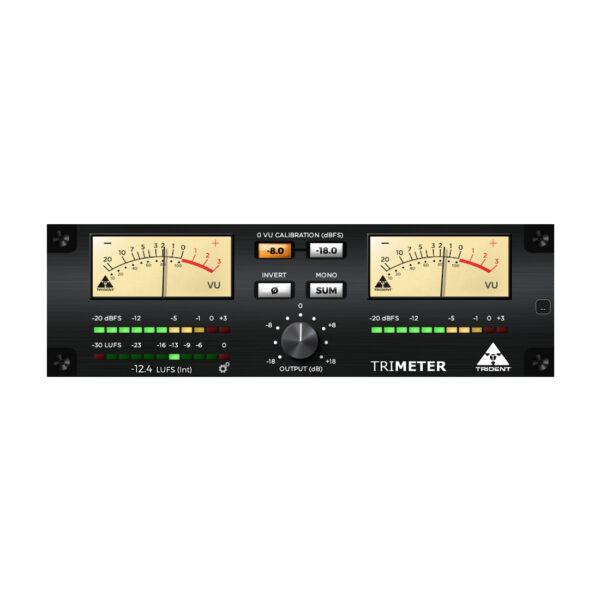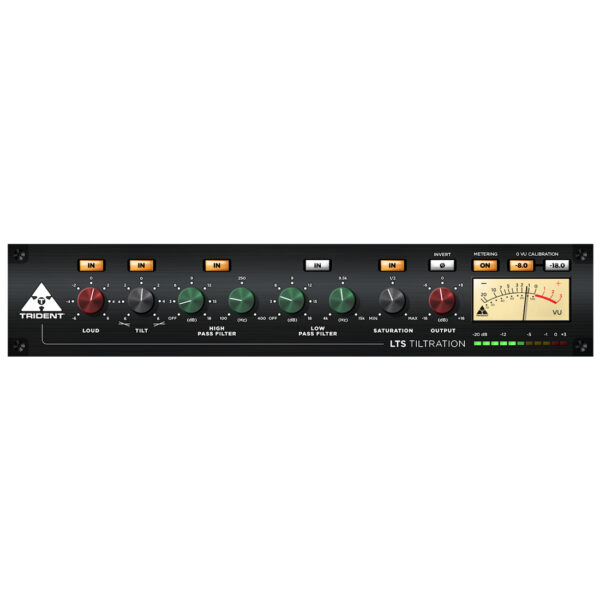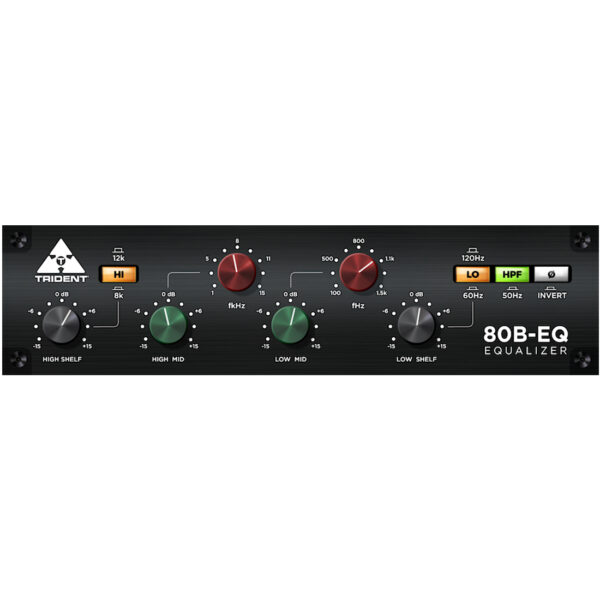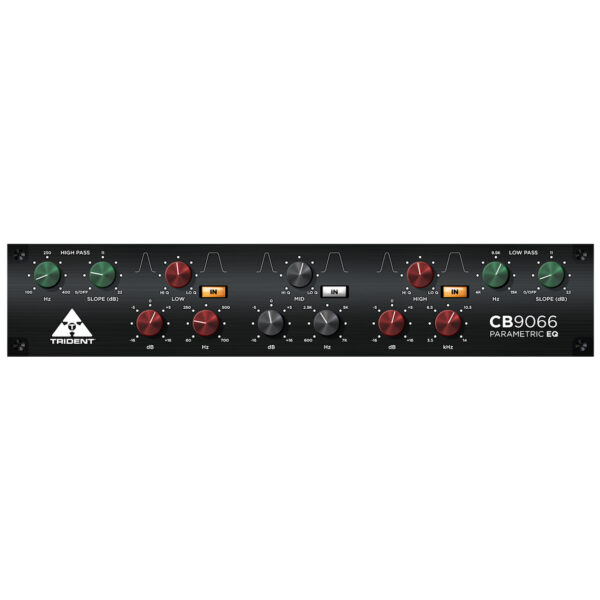- Overview
- Release Notes
- Quick Start Guide
- Specs
- FAQs
- Manual
Overview

TriMeter Plugin Demo
Use the link above to download a 7 day demo of the TriMeter Plugin
Multi-Application Audio Metering and Monitoring Plugin
TriMeter from Trident Audio Developments is a uniquely versatile and indispensable monitoring
tool, suited to a wide variety of audio applications and use cases. Through a selection of
meticulously implemented industry-established features, combined with a highly visual and
intuitive interface, TriMeter has been designed to enhance the many workflows and practices of
professional sound engineers, recording artists, content creators, and audio enthusiasts alike.
Features
VU Meters
TriMeter’s two VU displays, carefully modeled to match the specification and performance of
Trident’s legendary analog console meters, provide an essential function often overlooked in the
world of digital audio. Unlike the peak metering commonly found within DAW environments, VU
meters react similarly to the human ear, eEectively “averaging” or “smoothing” shorter
instantaneous peaks or transients for a more natural response. Referencing VU meters within
digital applications can often lead to clearer mixes and more natural sounding audio production.
With the ability to engage a 0 VU calibration of -18 dBFS at the touch of a button, TriMeter also
assists in achieving optimal gain structures and adequate headroom during recording.
PPM Meters
While VU metering offers many benefits such as those listed above, PPM or Peak Program
Metering can often provide a clearer indication of more rapid level changes and problematic spikes.
Not to to be confused with the peak metering capabilities of a DAW, PPM meters can and will still
mask the briefest of spikes or transients, instead offering a somewhat complimentary reference to
that of VU. TriMeter’s dual PPM implementations, located directly underneath each VU meter,
perform similarly to those found in classic Trident analog consoles, while additionally offering a
hybrid “clip hold” or over-level indicator for signals exceeding the equivalent of 0 dBFS.
LUFS Meter (Integrated)
LUFS (Loudness Units Full Scale) is the most modern method – and the industry standard – for
measuring and specifying loudness. While legacy metering such as VU and PPM still forms an
essential part of producing great sounding mixes and audio projects within digital environments,
the majority of broadcast and online streaming content platforms specify a “target” LUFS value,
which can vary greatly between organizations. Online creators, such as podcasters or content
producers for streaming applications, are increasingly tasked with meeting such targets. Unlike
other providers of LUFS measurement software applications and plugins, who often develop
complex (and often extremely expensive) solutions to highly specialized industry users, TriMeter’s
unique LUFS display implementation – while engineered to the exacting specifications of the
standard – offers a simple and visually intuitive method for monitoring integrated LUFS throughout a
program, performance, or project of any duration.
Linear Output Gain Control
Located in the center of the TriMeter graphical interface is a rotary output gain control. With +/- 18
dB of linear gain adjustment, channel gain can be decreased or increased to meet any number of
requirements, without adding any coloration, non-linear distortion, or “box sound” to the audio
itself.
Mono Summing
Summing two channels of (stereo) audio to mono is a technique often used within audio
engineering, mixing, and production. For example, it can be an effective way of subjectively
assessing the balance of left and right panned tracks and content within a stereo mix or project.
TriMeter offers a convenient one-button sum toggle function, when two input channels are being
processed.
Polarity Toggle
TriMeter offers a one-button polarity toggle function, often extremely useful for diagnosing and
correcting audible phase issues resulting from microphone placement or cabling errors.
Example Applications
• Add TriMeter to any track for Trident console-modeled VU and PPM metering
• Add TriMeter to a stereo bus/master, using LUFS integrating measurement to assess
loudness targets for music production, podcasts, and streaming content
• Activate high headroom VU monitoring (-18 dBFS) when tracking to assist with obtaining a
well-balanced, distortion-free mix
• Add TriMeter to any stereo track and toggle the Mono Sum mode to assist with balancing
individual elements or pans within a mix
• Add TriMeter to any stereo or mono track to make simple tweaks to gain or invert polarity
• Map parameters to a control surface for quick and easy operation
The Trident Digital Edition Series
In today’s recording environments, many in the recording world are working entirely within the digital domain. We believe working in the digital domain should not come at a cost for those who choose to work with some of the most iconic outboard gear in music production history.
With a rich analog recording history of over 50 years, Trident Audio Developments are perfectly suited to offer the new Trident Digital Editions Plugins, which bridge that gap between analog and digital recording, while accurately recreating the historic analog gear of yesterday for the digital domain. The Trident Digital Editions, give those the opportunity to work with the iconic gear that produced so many classic hit records.
TriMeter Release Notes
TriMeter
Version 1.1.0 – 02 September 2024
• Initial release
Quick Start Guide
Quick Start Guide: Installation in Five Easy Steps
Step 1: Download the correct installer for your system from the Downloads page. If you are
unsure which installer to choose, scroll down to System Requirements for more details on
selecting the most suitable version.
Step 2: Close any currently open instances of your DAW or music creation applications.
Step 3: Open the downloaded disk image (macOS) or executable (Windows) and doubleclick
on the installer file to begin the installation process. Follow the on-screen prompts.
Step 4: Once the installation process is complete, open your DAW application. Note that
there may be a slight delay while your system detects and verifies your newly installed
plugin for the first time.
Step 5: Open your new plugin within your DAW session and click the Activate Plugin
button. Follow the on-screen prompts which will automatically open a browser window.
Select either the Start Trial or Use License option and follow the prompts to activate.
System Requirements
Apple macOS
• Apple Audio Unit (AU), Steinberg VST3, and Avid AAX plugin formats
• Requires macOS 10.13 (High Sierra) or greater
• Native support for Intel (x86_64) and Apple Silicon M-Series (arm64)
Microsoft Windows
• Steinberg VST3 and Avid AAX plug-in formats
• Requires Windows 10 (64-bit) or greater
Should you encounter any problems, please contact us at plugins@pmiaudio.com
Product Specifications
| Feature | Details | Controls |
| VU Meter | Analog Console-style VU Metering with Calibration Level Toggle | -8.0 / -18.0 dBFS |
| PPM Meter | Console-style Peak Programme Ladder Metering with Dual-level Clip Hold | N/A |
| LUFS Meter | Loudness Units Full Scale (Integrated Mode) Ladder Target Metering | Reset |
| LUFS Value | Loudness Units Full Scale (Integrated Mode) Value Display | On / OP / Reset |
| Invert | Polarity Inversion | On / OP (Default) |
| Mono | Mono Summing (2-Channel / Stereo Inputs Only) | On / OP (Default) |
| Output Gain | Output Gain Boost / Cut | +/- 18 dB |
Frequently Asked Questions
Trident plugins are available in VST3 (macOS and Windows), AAX (macOS and Windows),
and Audio Unit (macOS only) formats.
Trident plugins are compatible with Apple macOS 10.13 (High Sierra) or greater and
Microsoft Windows 10 (64-bit) or greater.
We’ve developed our plug-ins in line with the strict requirements of Apple Audio Unit (AU), Steinberg VST3, and Avid AAX frameworks. Although we have carried out extensive testing across multiple DAWs on both Mac and Windows, we cannot guarantee compatibility with every host; we recommend downloading our free demo to confirm functionality with your chosen DAW.
Trident plugins are no longer available in 32-bit format.
Each DAW has its own method for managing plugin presets; please refer to the help files within your DAW for more information. We recommend that you save your Trident plugin’s factory default state as a unique preset before starting to experiment with parameters.
All software download purchases made on our website are non-refundable per our End
User License Agreement (EULA).
Should you encounter any problems, please contact us at plugins@pmiaudio.com
Trident TriMeter - Multi-Application Metering and Monitoring Tool
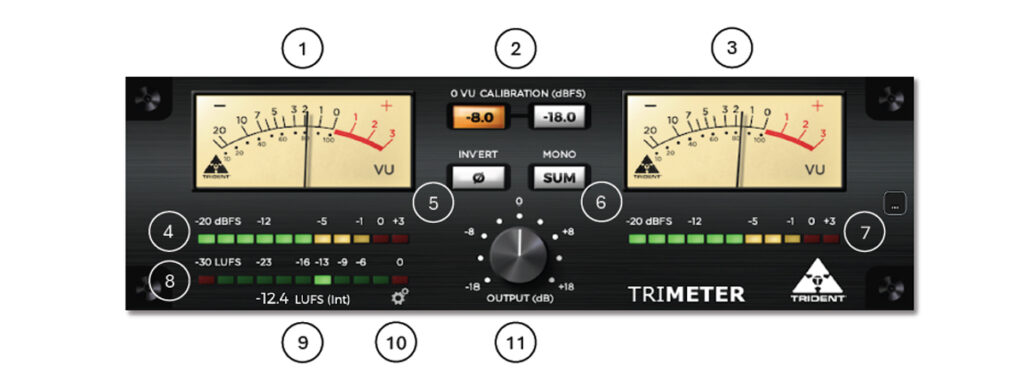
Legend
1 – Left/Channel 1 VU Meter
2 – 0 VU Calibration -8.0/-18.0 dBFS
3 – Right/Channel 2 VU Meter
4 – Left/Channel 1 PPM Meter
5 – Polarity Inversion On/Off
6 – Mono Sum Mode On/Off
7 – Right/Channel 2 PPM Meter
8 – Integrated LUFS Meter (Left/Channel 1 & Right/Channel 2)
9 – LUFS Current Value Display
10 – LUFS Options: Show/Hide Current Value Display*; Reset Metering*
11 – Output Gain Control: Double-Click Dial for Text Entry Mode
* Alternatively, double-click on the LUFS meter to toggle between show/hide value; right-click
on the LUFS meter to reset.
Example Use Cases
o Add TriMeter to a stereo bus/master as the last plug-in in a chain, for Trident console modeled
metering and/or integrated LUFS calculation.
o Add TriMeter to any stereo track and toggle the Mono Sum mode to assist with
balancing individual elements or pans within a mix.
o Add TriMeter to any stereo or mono track to make simple tweaks to gain or invert polarity.
o Activate high headroom VU monitoring (-18 dBFS) when tracking to assist with
obtaining a well-balanced, distortion-free mix.
o Map parameters to a control surface for quick and easy operation.
